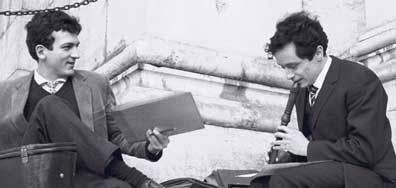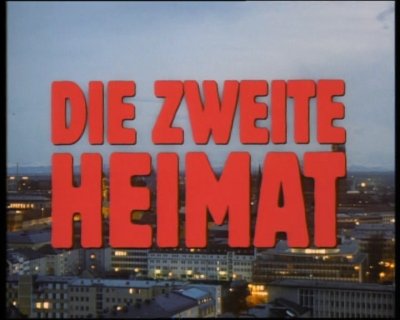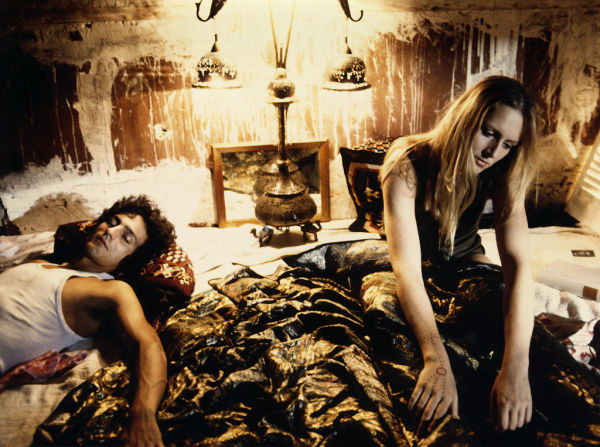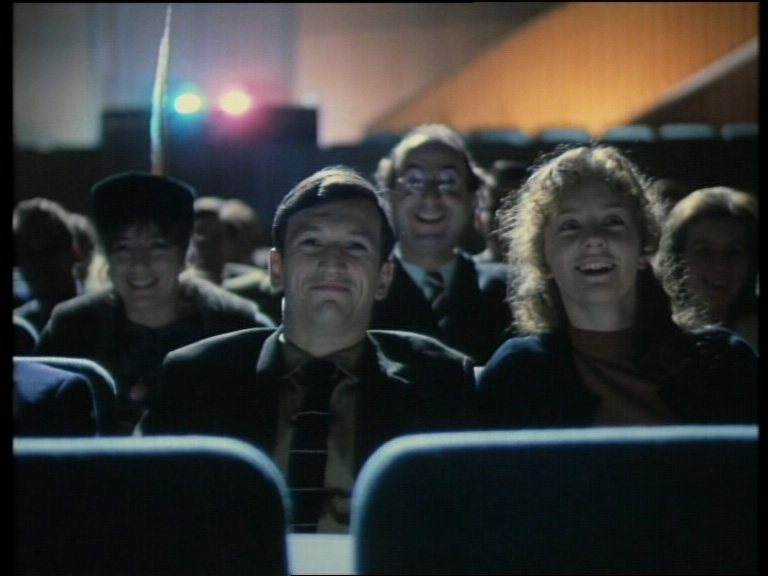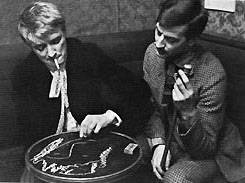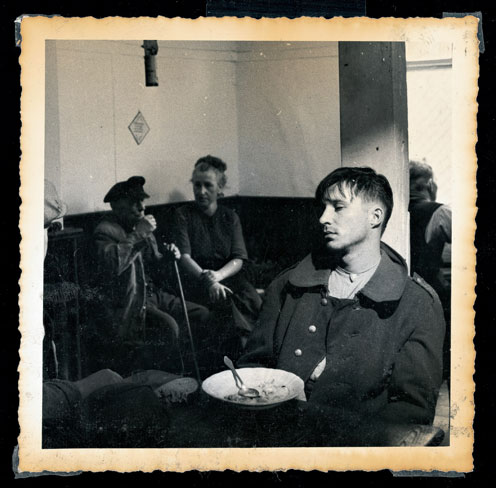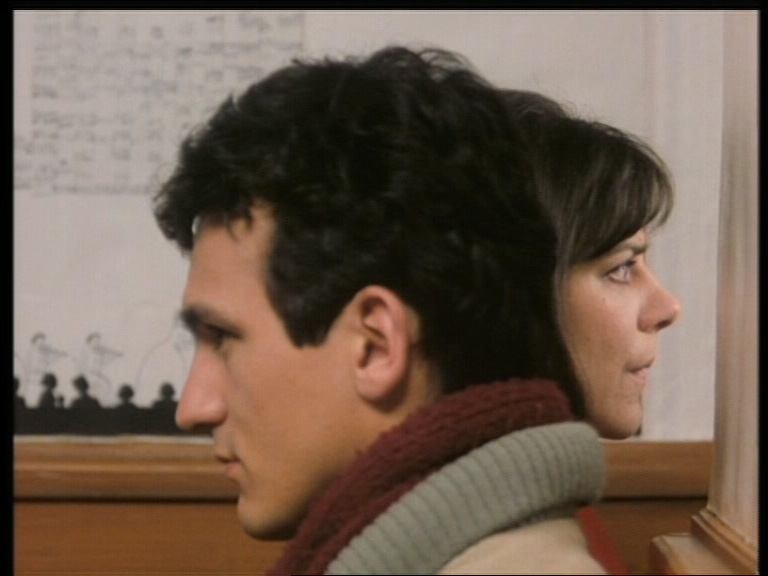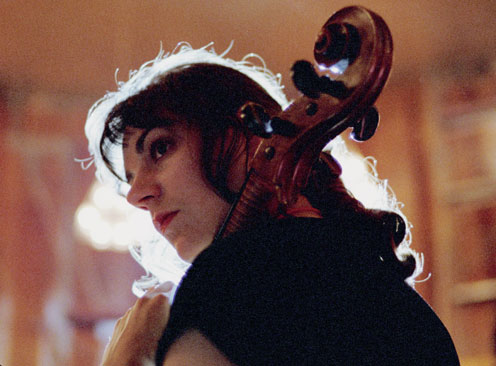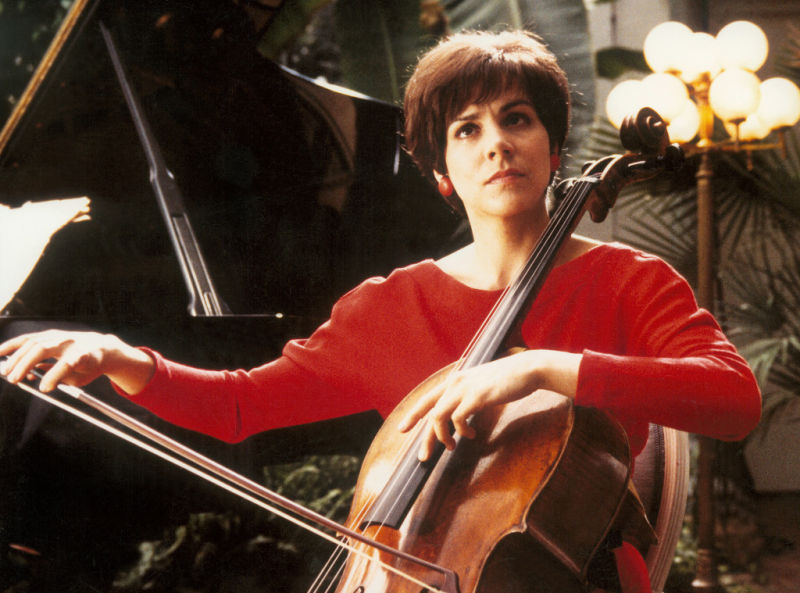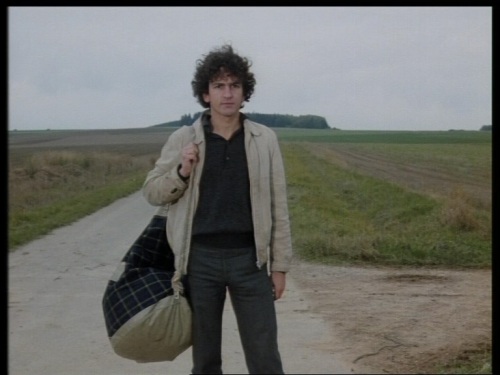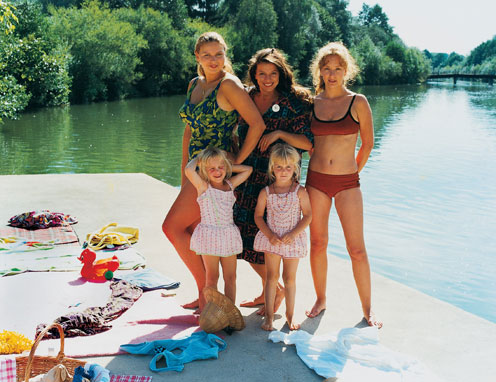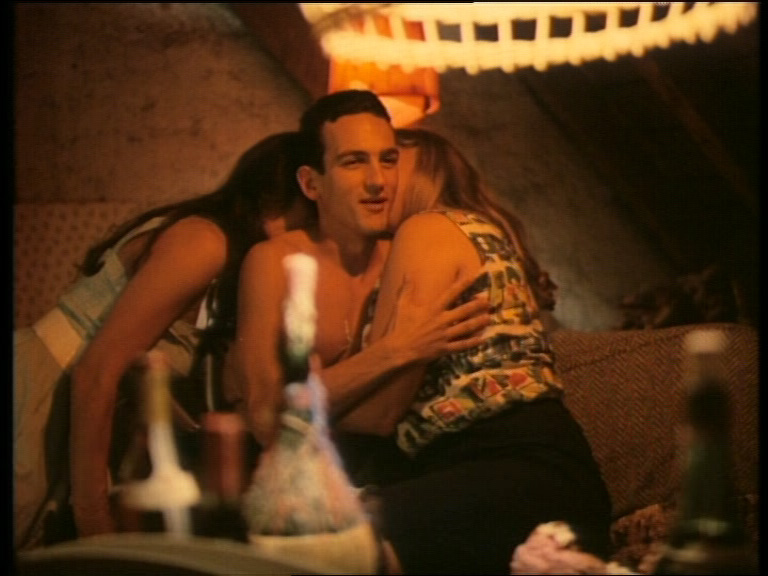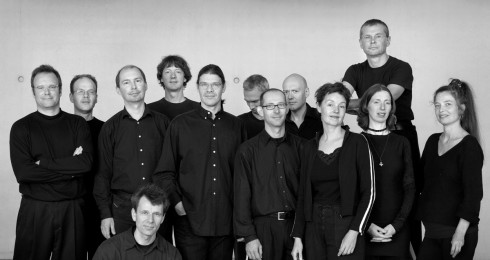From the Chicago Reader (May 6, 1994). I haven’t reseen The Second Heimat since then, and it would be interesting to discover how it holds up today. — J.R.
**** THE SECOND HEIMAT
(Masterpiece)
Directed and written by Edgar Reitz
With Henry Arnold, Salome Kammer, Daniel Smith, Noemi Steuer, Armin Fuchs, Martin Maria Blau, Laszlo I. Kish, Frank Roth, Anke Sevenich, Franziska Traub, Michael Schonborn, Hannelore Hoger, Susanne Lothar, Alexander May, and Peter Weiss.
Why is it so hard to be happy? — Clarissa in the seventh episode of The Second Heimat
The 60s and early 70s reveled in long, ambitious works — movies and music alike — epic, multilayered statements that through their unwieldy lengths alone challenged and disrupted the flow of everyday life. In jazz there were Ornette Coleman’s Free Jazz and John Coltrane’s A Love Supreme, in rock Sgt. Pepper’s Lonely Hearts Club Band, We’re Only in It for the Money, and Tommy, and when rock and movies came together in Woodstock (1970) the running time was three hours — about as long as a marijuana high.
An interesting paradox: to go to a long concert or long movie during that period was to be “somewhere else,” but that didn’t necessarily mean to escape. At best it meant to redefine where one already was, perhaps even to learn something about how to go about changing it. 2001: A Space Odyssey (1968) and Playtime (1967), mind-boggling, wide-screen efforts to reeducate us by breaking our basic habits of organizing visual and spatial data, both clocked in at about 155 minutes in their original versions, while the relentless, continuous camera movement of Michael Snow’s amazing La region centrale (1971) offered an even more rigorous visual education over three uninterrupted hours. The first long features of Jacques Rivette, all concerned in different ways with the interface between life and art making — L’amour fou (1968, 252 minutes) and the two versions of Out 1 (1971, 760 minutes; 1972, 255 minutes) — were just as surely efforts to reeducate our sense of time and duration. To some extent, earlier long films like Michelangelo Antonioni’s L’avventura (1960, 145 minutes) had already begun to reeducate our sense of time, as well as space. And it was in the 60s that the extraordinary silent serials of Louis Feuillade — Les vampires, Tih Minh, Judex (showing at the Film Center in a couple of weeks) — first were shown in the U.S. in single screenings, delicious six- and seven-hour marathons. And Andy Warhol’s 25-hour **** (“Four Stars”) was shown in New York during that era for the first and only time.
The point of citing all these examples is that the revolutionary politics and artistic ferment we associate with the 60s and early 70s weren’t independent phenomena. They were separate manifestations of the same radical impulses, all relating to the same compulsion to break the ossified habits of postwar prosperity in Europe and the U.S., to transform the quality and potentiality of life itself.
Bearing this in mind, it isn’t the smallest merit of Edgar Reitz’s 13-part, nearly 26-hour The Second Heimat (1992) — a vast, novelistic meditation on young artists in Munich, mainly classical musicians and filmmakers, between 1960 and 1970, playing at the Film Center on Thursdays and Sundays for the remainder of this month — that the very act of attending to it essentially duplicates a 60s experience. This is true whether you see it in a marathon or in irregular installments, as I did while previewing it on video. One’s ordinary life is significantly disrupted — even unhinged — by the process of taking it all in. Even some of my customary critical reflexes were altered, because the experience of duration changes everything. (Not being able to read some of the subtitles on video, for instance — a problem virtually eliminated in the 35-millimeter prints being shown — seemed less important than it would have been in a normal feature.) For to agree to see a film of this length is of necessity to step off the conveyor belt of life — life as it’s usually defined, experienced, processed, and understood–and to grant an importance to art as a reflection of life that’s fundamentally at odds with the conventional consumption patterns of moviegoing. Most movies defined by our 90s culture as central are designed to be seen in two hours and then forgotten. But The Second Heimat, whether sampled or seen in its entirety, requires that one engage with a train of thought that carries over from one two-hour episode to the next, that follows one around for days or weeks as it’s developed and revised during and between each installment.
That the subject of this train of thought should be the 60s seems entirely appropriate, though that, along with the running time, may help to account for the deafening critical silence with which this major work has been greeted in most places. To the best of my knowledge, it has not been reviewed in London’s Sight and Sound or Paris’s Cahiers du Cinema and Positif, and it received next to no attention when it showed in New York several months ago. I’ve also been told that the film flopped in Germany — unlike its nearly 16-hour predecessor by Reitz, Heimat (1984), which I’ve sampled only briefly. The German history professor who told me this hadn’t seen The Second Heimat, but speculated that its commercial failure was attributable to bad timing on Reitz’s part — dealing with the 60s a few years before most people, including historians, feel ready to deal with the subject.
I don’t mean to imply by any of this that The Second Heimat, alternately known as Leaving Home, is a radical work in any sense other than its duration — even if it proves to be (as it surely will) ahead of its time. Stylistically assured, it is more precisely a kind of classical summing up of 60s filmmaking — which was radical in its own time but not today — than it is an innovative work. (Three of the principal reference points — Hawks’s 1959 Rio Bravo, Truffaut’s 1961 Jules and Jim, and Antonioni’s 1961 La notte — are all cited directly in the early episodes.) Suffused with the spirit of German romanticism, which entails a certain amount of fatalism, this “chronicle of a generation” remains spellbinding throughout as sheer story telling and provocative and suggestive as historical analysis, while its complex, shifting characterizations of all the major figures remain searchingly novelistic in the best sense. But it still doesn’t break new ground.
Its political orientation, moreover, is far from radical. Though a certain amount of ambivalence and irony is shown toward the aspirations and achievements of all the characters, radicals and nonradicals alike, the treatment of most of the explicit political activity is rather superficial, even jaundiced — prematurely disillusioned, one might say. (Most astonishing, unless I missed something, the May events of France in 1968 aren’t alluded to even once.)
This is surprising given Reitz’s multiple connections with Marxist filmmaker Alexander Kluge, as codirector and as cofounder of a Munich film school. But Reitz, who was born in 1932, is eight years older than his hero, perhaps the least politically committed of all the major characters; the generation Reitz is chronicling isn’t fully his own, which creates a distance that has certain negative as well as positive aspects. It’s worth adding that the actions of the major women characters in the film — who take their politics much more seriously than most of the men — anticipate the developments of feminism in the 70s, which Reitz seems sympathetic to.
It might be argued that the film’s skepticism about politics is clearest when it broaches the question of the Nazi past — the point where Reitz seems to discover that even a 26-hour film can bite off more than it can chew. The issue is raised by the political awakening of Reinhard (Laszlo I. Kish), a filmmaker who’s older than most of the other characters and closer to the age of Reitz. A heavyset loner preoccupied during the early episodes with guns, westerns, and filmmaking, Reinhard is most often perceived as a secondary character until, like many of the other figures in the film, he finally commands a full episode of his own, the tenth. Traveling from Munich to Venice in search of financing for a feature he wants to make, Reinhard becomes romantically and sexually involved with Esther (Susanne Lothar), a troubled photographer whose parents are a former SS member and a Jewish woman who perished in the gas ovens. In more ways than one, the difficulty of Esther’s tangled emotional legacy, which steadily unpacks Reinhard’s vulnerability — especially in one striking scene when she seduces him while simultaneously photographing and undressing him — becomes the story Reinhard wants to tell in his feature, which in some respects is his story as well. (His father, an air force officer whom he reveres, dropped bombs on Guernica.)
Yet after Reinhard returns to Munich ready to launch his project, he’s perversely prevented from realizing it. It’s as if Reitz is implying that any effort to exhume the complexities of the Nazi past is somehow doomed to failure. But is it simply a failure of nerve on Reitz’s part to turn away ultimately from the issues Reinhard and Esther are obsessed with? Certainly this sense of incompletion casts an almost palpable malediction over the remaining three episodes, so the issues obstinately remain, even if the characters fail to follow them to the end. In the final analysis, one comes away from The Second Heimat asking whether this failure belongs to Reitz or to the history of the 60s. There are no easy answers.
Hermann, who as a teenager figured as a character in Heimat — which covers the years 1919 to 1982 in Germany from the vantage point of a single fictional village named Schabbach — was known there for becoming involved with a female refugee who was 12 years older, until his mother and stepfather forced them apart. At the beginning of The Second Heimat — in 1956, when he’s 18 — he has locked himself in his room in protest and is crying. Then he opens his window, looks out, and prays to God, making three solemn vows: that he will never love again; that he will leave Schabbach after he passes his exams at 20 and never come back, even when he’s famous; and that “music shall be my only love and my only home.”
Shortly after he makes this vow, as he kneels by his bed, the wind from the window blows shut the door behind him. On this door is a mirror, and Hermann turns his head to look at himself from behind. This is the first of many such images that punctuate the film as a whole, one that seems to encapsulate Hermann’s querulous view of himself as an objectified, retreating figure, fulfilling — or more often failing to fulfill — his vows. Sometimes the variations on this image are highly ironic: later in the first episode, shortly after Hermann — a gifted, albeit vain, composer, conductor, pianist, and guitar player, now 20 — moves to Munich, we catch him cheating on his entrance exam at the music conservatory when asked to identify notes struck on a piano behind him (he sees a reflection of the keys on the polished surface of the piano lid). Another such image appears much later, in the highly erotic and affecting fifth episode, “The Game With Freedom,” which in some respects anticipates Reinhard’s story; it’s set mainly in June 1962, when real-life riots broke out in Munich after police attacked several students, and we see Hermann’s guitar getting smashed in the melee. He winds up fleeing from a police beating to the hometown of Helga (Noemi Steuer), a sensitive poet who’s hopelessly smitten with him. Helga and her two best female friends slowly undress him while they dress a wound on his back, then fall into a spontaneous bout of four-way lovemaking until Helga literally faints from the excitement. During this sequence Hermann inadvertently backs into the surface of a cold mirror, flinches, and then cranes his neck around and sees himself.
Another delayed rhyme effect occurs seven episodes and many years later, when Hermann — having momentarily fled his wife and child in Munich to stay in a hippie commune in Berlin — becomes involved in another freewheeling group grope: he freaks out and retreats after another man starts to fondle his temporary girlfriend Kathrin. The game of freedom, one might say, makes him a loser rather than a winner in his own mind when he, rather than Helga or her friends, has to agree to the sexual sharing. This demonstrates one of the film’s countless dialectical views of freedom, countercultural and otherwise — most often beginning with hope and ending in disillusionment. But where Helga’s romantic frustrations ultimately drive her into radical politics and then terrorism, the film’s virtual heroine, Clarissa (Salome Kammer) — a gifted cellist and singer Hermann hankers after for all 13 episodes — arrives at her own form of dissidence and revolt as a logical fulfillment of her artistic destiny, which takes her a full decade to find and achieve. (The last and longest episode, in which this finally becomes apparent, is significantly called “Art or Life.”)
Apart from countless rhyming images and themes, The Second Heimat has various other organizing principles. The episodes are set more or less during successive years, and each is focused mainly on a character who’s part of the ensemble of Munich friends in the other episodes. (For this reason most of the intermediate episodes can be seen as fairly self-sufficient features; nuances will be lost, but one doesn’t have to see all of the chapters.) Some episodes cover weeks or months, others less; the sixth, “Kennedy’s Children,” concentrates on the events of November 22, 1963, the day John F. Kennedy was shot. (Due to the time difference, the news reaches Germany in the evening, interrupting a commercial screening of Cleopatra Hermann is attending with a former girlfriend from his hometown, who subsequently becomes his wife.)
Most of the leading characters are introduced during Hermann’s first two days in Munich, and their circle is solidified in the second episode after a night in a jazz club when a wealthy older woman named Elisabeth Cerphal (Hannelore Hoger) invites them to her nearby villa, known as Foxholes, where many of them wind up living, congregating on a regular basis, and holding concerts over the next six episodes. This extended stretch, adding up to over half of The Second Heimat, culminates in Hermann’s wedding party at Foxholes, which ends with a violent event that leads Elisabeth to abruptly terminate her stint as patroness and eject all but one of the circle, a multitalented Chilean musician named Juan (Daniel Smith).
The ninth episode focuses on the troubled Nazi past of Elisabeth and her father, and after Foxholes is razed to make way for a housing complex, the loss of the artistic community it housed becomes the inspiration for two ambitious artworks conceived by its former members — a Foxholes Requiem by Hermann and the feature film by Reinhard, the focus of the tenth episode, “The End of the Future.” (“Even the space it took up is gone,” Reinhard remarks sadly as he and a cameraman try to film the empty site. “All this glass eye can do is goggle.” Later the story of Foxholes inexorably becomes the story of the troubled Esther.)
By and large, the musicians tend to dominate the early episodes, and the filmmakers become more prominent in the later ones. Reitz has much better luck creating a believable musicians’ world and milieu. One reason is that most of these characters are played by trained musicians — including Hermann, Clarissa, Juan, and Volker (Armin Fuchs); the many sequences that include their performances of contemporary and avant-garde music are among the film’s dramatic highlights. (The highly versatile score is by Nikos Mamangakis.) One wonders if Reitz may simply be too close to the material concerning the filmmakers; the results in any case seem a good deal more forced and fanciful.
Though I can’t speak with any authority about Heimat, it’s generally known that Reitz was provoked to make it in part by the sensation caused by the showing of the U.S. miniseries Holocaust on German TV in 1979. “After the screening of this awful film,” Reitz was quoted as saying the following year, “it has become clear that we must offer a work from our point of view, the Germans, and not from America; all the discussions which took place after Holocaust have shown that we must dare to confront this past, that distancing ourselves we arrive at nothing and change nothing.” Elsewhere, according to Thomas Elsaesser in New German Cinema: A History, Reitz argued that “whatever happens in future to the cinema as a physical place where films are being shown publicly, what matters is that every country should be able to preserve a space where human beings can ‘encounter their own lives, their own world of experience in the constructed and heightened form which is the work of film.'”
Even from the little I saw of Heimat it was clear that Reitz’s ambition was to create a national space of this kind, a collective myth. For some critics it was a space that failed to engage adequately with the Nazi past, precisely because it was addressed to his countrymen. This is clearly less true of The Second Heimat, where the space created and the collectivity implied are decidedly more international — not only because the 60s themselves are a more international subject, but also because being young and American or European in the 60s meant to some extent being international. And even if Reinhard winds up doomed by Reitz’s romantic fatalism, it’s clear that many aspects of his inquiry into the Nazi past are seriously engaged with: the very fact that the Munich music conservatory where Hermann and his musician friends are enrolled was a former Nazi headquarters is frequently evoked and discussed.
To call the film international isn’t to argue that the history of Germany from the vantage point of young Munich artists in the 60s was identical to that of young artists in New York or Chicago or Paris or London. Nevertheless there were strong bonds of common experience, political as well as aesthetic. (Why else, for instance, would Kennedy’s assassination assume the importance it does?) As far as the counterculture is concerned, some trends, like taking hallucinogenic drugs, became popular in continental Europe somewhat later than they did on American campuses, which undoubtedly helps explain why such drugs don’t put in an appearance in The Second Heimat until the 11th episode, circa 1967. Conversely, one might argue that terrorism entered radical politics in Germany earlier and more significantly than in many other places, and the forms of governmental retaliation it provoked were also different. These and other differences from our own experience or understanding of the 60s necessarily affect our reading of The Second Heimat, but they don’t prevent us from engaging with the dialogue engendered by the film. There’s still plenty of room in the shared space to encounter our own lives.
The title is not meant to indicate a continuation of Heimat, but rather it refers to that place which we, as adults, find: the place we choose of free will and which we call our second home. Profession, friendships and the family we ourselves establish comprise this home we choose. It is based on decisions we ourselves make. But love, friendship and profession are values which decay very easily. In our second home, we live on very unsure ground. We don’t want to give up our demand to be free, which is also dangerous to all of our commitments. The second home is always a temporary one. — Edgar Reitz
A history of objects — Foxholes, a guitar purchased by Hermann, a cello purchased by Clarissa — as well as characters, The Second Heimat shifts between color and black and white in every episode, often in ingenious ways and never arbitrarily. (As Reitz has pointed out, “What takes place after sunset is shot in color. This concept is only rarely broken.”) One of the subtle effects of this technique is to give us a sense of changing perspectives on the characters, settings, objects, and events; the same principle can be seen in the regular shifting to different characters as narrators or as narrative subjects.
What emerges from this is an extremely dense, textured group portrait that achieves many of its finest moments in parties, concerts, nightclubs, and other gatherings, where the mise en scene generously offers us many separate points of entry into the narrative and where the narrative development is often quite musical. (One character or set of characters that figures as “accompaniment” or “harmony” in one sequence may later become the solo melody, only to return to the orchestral ensemble afterward.)
A characteristic example of Reitz’s strength as a multilayered storyteller is his handling of Renate (Franziska Traub) — a beautifully realized character who appears in practically every episode, though she isn’t accorded an episode of her own. At once shy and exhibitionistic, lonely and gregarious, awkward and aggressive, she shifts over the course of the film from being a secretary and law student to pursuing a career as an actress without much success to achieving some relative degree of professional fulfillment as a stripper and waitress at a nightclub where most of the characters hang out; she also has passing sexual involvements with some of the central male characters prior to her work at the nightclub. She never figures in the film as a static element–as a running gag or simply as a familiar presence — but evolves at every moment, teaching us things about the other characters when she interacts with them and teaching us things about ourselves when she confounds our expectations about who she is and what she’s like.
In a larger sense, what can be said about Renate can also be said about the overarching themes and subjects of the work as a whole: art versus life; “first home” versus “second home”; freedom versus conditioning; career versus love, friendship, and family; present versus past and future; collectivity versus solitude; and finally the 60s in relation to both the 30s (when a more sinister kind of “counterculture” was entering the German mainstream, led by a bohemian artist named Adolf Hitler) and the 90s. Without ever succumbing to the temptations of a thesis film, Reitz has proposed through his vast tapestry a forum that allows us to interrogate and examine our own pasts — not all of us in the same way, but with the film speaking back to us at every turn. What he has offered, in other words, is a place to start, a conversation to engage in — a way of thinking about our own lives.


